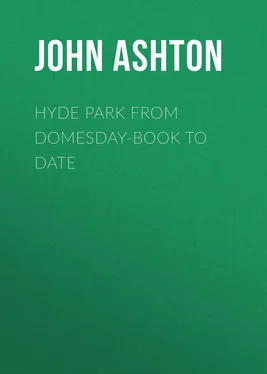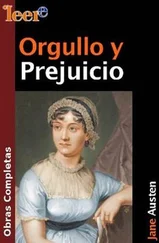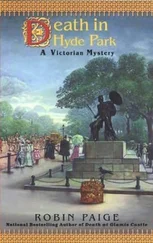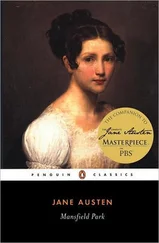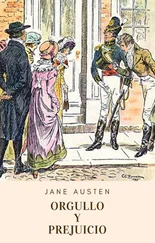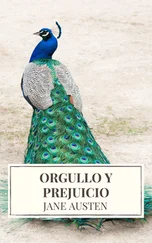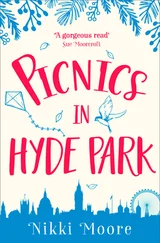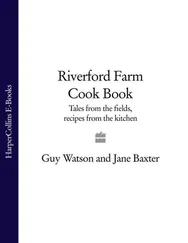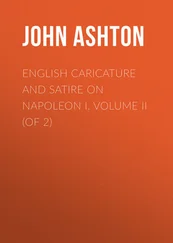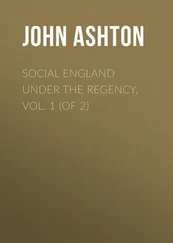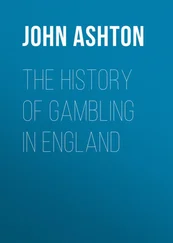John Ashton - Hyde Park from Domesday-book to Date
Здесь есть возможность читать онлайн «John Ashton - Hyde Park from Domesday-book to Date» — ознакомительный отрывок электронной книги совершенно бесплатно, а после прочтения отрывка купить полную версию. В некоторых случаях можно слушать аудио, скачать через торрент в формате fb2 и присутствует краткое содержание. Жанр: foreign_antique, foreign_prose, на английском языке. Описание произведения, (предисловие) а так же отзывы посетителей доступны на портале библиотеки ЛибКат.
- Название:Hyde Park from Domesday-book to Date
- Автор:
- Жанр:
- Год:неизвестен
- ISBN:нет данных
- Рейтинг книги:3 / 5. Голосов: 1
-
Избранное:Добавить в избранное
- Отзывы:
-
Ваша оценка:
- 60
- 1
- 2
- 3
- 4
- 5
Hyde Park from Domesday-book to Date: краткое содержание, описание и аннотация
Предлагаем к чтению аннотацию, описание, краткое содержание или предисловие (зависит от того, что написал сам автор книги «Hyde Park from Domesday-book to Date»). Если вы не нашли необходимую информацию о книге — напишите в комментариях, мы постараемся отыскать её.
Hyde Park from Domesday-book to Date — читать онлайн ознакомительный отрывок
Ниже представлен текст книги, разбитый по страницам. Система сохранения места последней прочитанной страницы, позволяет с удобством читать онлайн бесплатно книгу «Hyde Park from Domesday-book to Date», без необходимости каждый раз заново искать на чём Вы остановились. Поставьте закладку, и сможете в любой момент перейти на страницу, на которой закончили чтение.
Интервал:
Закладка:
At least this was the plea of those who broke down the fences, etc., in 1592. “The Parishioners, having, as they supposed, that Lord’s 11 11 Lord Burghley, High Steward of Westminster.
Countenance, sent divers Persons on the 1 of August , being Lammas day , who, with Pickaxes, and such like Instruments, pulled down the Fences, and brake the Gates, having with them the Bailiffs and Constables, to keep the Peace.”
The Manor of Neate lay alongside the river Thames, and although we have seen that the old moated mansion was of some importance, still, at the time of the above dispute (in which it shared with the neighbouring manor), it was only termed a farm , the house and all the ground around it having been granted by Edward VI. to Sir Anthony Brown; still the name of the manor was perpetuated in the “Neat Houses” – which were places of rural entertainment, and which Strype (Book vi. p. 67) describes: “The Neat Houses are a Parcel of Houses, most seated on the Banks of the River Thames , and inhabited by Gardiners; for which it is of Note, for the supplying London and Westminster Markets with Asparagus , Artichoaks , Cauliflowers , Musmelons , and the like useful Things that the Earth produceth; which, by reason of their keeping the Ground so rich by dunging it (and through the nearness to London , they have the Soil cheap), doth make their crops very forward, to their great Profit in coming to such good Markets.”
There are no traces of these “Neat Houses” now; they disappeared entirely before the destructive builder, but they were in existence during this century, and stood where now is St. George’s Row, Warwick Street, Pimlico. Yet it is evident that before it sunk wholly into market gardens, the “Neat Houses” was a place of amusement where people of good standing in society might attend without prejudice. In those days people’s tastes were much simpler than in our time, and drinking syllabubs, and playing at an imaginary Arcadian life with imaginary Chloes and Strephons was fashionable.
It would be hard, indeed, if Pepys had nothing to say about this suburban place of entertainment, where he takes his wife and Mistress Knipp, an actress, of whom his wife was jealous. “Aug. 1, 1667. After the Play, we went into the House, and spoke with Knipp , who went abroad with us, by coach, to the Neat Houses , in the way to Chelsy ; and there, in a Box in a Tree, we sat and sang, and talked and eat; my wife out of humour, as she always is, when this women is by.” And again, “May 28, 1668. Met Mercer 12 12 Who had formerly been a kind of companion to his wife.
and Gayet , and took them by water, first to one of the Neat Houses , where walked in the Gardens, but nothing but a Bottle of Wine to be had, though pleased with seeing the garden; and so to Fox Hall, where with great pleasure we walked, and then to the upper end of the retired walk, and there sat and sang, and brought a great many gallants and fine people about us; and, upon the bench, we did by and by eat and drink what we had, and very merry.”
It seems a pity after such a merry scene to chronicle a death, but it was not a common one. Domestic Intelligencer, August 5th, 1679. “We hear that Madam Ellen Gwyn’s mother, sitting lately by the water-side at her house by the Neate Houses , near Chelsea , fell accidentally into the water, and was drowned.”
There seems no reason to doubt but that Henry VIII. wanted these manors for the purpose of hunting, as they lay so contiguous to the 100 acres which, in 1532, he had added to St. James’s Park; and that this was his intention is shown by a proclamation made in 1536, wherein the King, who was passionately fond of all field sports, and excelled in them, as in every other manly exercise, says, that being desirous of having hares, patridges, pheasants and herons preserved round about his Palace of Westminster, for his own disport and pastime, forbids anyone, under pain of imprisonment, and further punishment according to his will and pleasure, either to hunt or hawk “from the Palace of Westminster to St. Giles’ in the Fields, and from thence to Islington, to Our Lady of the Oak, to Highgate, to Hornsey Park, and to Hampstead Heath.”
Hyde Park was then of much greater extent than it is at present, and comprised 620 acres; but what with the portion taken to add to Kensington Gardens, and land taken away at Hyde Park Corner, it now does not measure 400 acres. There is very little doubt but that when this manor of Hyde came into the possession of Henry VIII. he fenced it round, because its northern, southern, and eastern boundaries were all public roads, and, although in all probability men would not dare to poach on this Royal manor, yet the feræ naturæ must necessarily have been kept within bounds if there was to be hunting or any other kind of sport. And it must have been a high fence, for deer were plentiful, and they certainly were hunted and shot. In a letter from the Lords of the Council to Sir John Masone, 13 13 England under the reigns of Edward VI. and Mary, by P. E. Tytler. Lond. 1839, vol i. p. 288.
ambassador from England at the French Court, dated June 2nd, 1550, and giving an account of the reception and amusement of the embassy of Messrs. de Chastillon, Mortier and Bouchetel, who were sent by Henry II. to receive Edward’s ratification of the treaty by which Boulogne had been ceded to France for the sum of 400,000 crowns, we find that, “Upon Tuesday, the King’s Majesty had them on hunting in Hyde Park, and that night they supt with his Highness in the Privy Chamber.”
Queen Elizabeth also hunted in Hyde Park – and, like her brother, offered sport therein to noble visitors. For instance, she so entertained Count John Casimir, son of Frederick III., Elector Palatine, and a general in the Dutch service, as we learn from the Talbot Papers, 14 14 Illustrations of British History, etc., by E. Lodge. Lond. 1791, vol. ii. p. 205.
in a letter from Gilbert Talbot and his wife to the Earl and Countess of Shrewsbury, dated February 13th, 1578. “My L. of Lecester also hath geven him dyvers other thynges, as geldynges, hawks and houndes, woddknyves, falchyones, hornes, crossebowes, and sondry peces of brode clothe fytte for huntynge garmentes, bothe for wynter and sumer, for he delyghtethe greatly in huntynge, and can chouse his wynter deere very well. He kylled a barren doe w thhis pece this other daye in Hyde P’ke from emongst CCC other deere.” And to show that the Queen herself, if she did not actually join in the sport, looked on, there is an entry in the accounts (1582) of the Board of Works, of a payment “for making of two new standings in Marybone and Hyde Park, for the Queen’s Majesty and the Noblemen of France 15 15 The Duke of Anjou and his Court.
to see the hunting.” This is also mentioned by John Norden in his Notes on London and Westminster (1592). “Hyde Park substancially impayled with a fayre lodge and princelye standes therein. It is a stately parke and full of fayre game.”
In the 1575 edition of Geo. Turberville’s “ Noble Art of Venerie or hunting ” (p. 95) we have a fine picture of Queen Elizabeth on one of these stands, whilst, kneeling on the ground, and bareheaded, the royal huntsman presents the “fewmets,” or droppings of the deer, on some leaves, in a plate, for the Queen’s inspection; and the following is “The report of a Huntesman upon the sight of an Hart, in pride of greace.
“ ‘Before the Queen, I come report to make,
Then husht and peace, for noble Tristrame’s sake.
From out my horne, my fewments first I drawe,
And then present, on leaves, by hunter’s lawe;
And thus I say; my Liege, behold and see
An Hart of tenne, I hope he harbored bee.
For if you mark his fewmets every poynt,
You shall them find long, round and well anoynt,
Knottie and great, without prickes or eares,
The moystness shewes what venison he beares.’ ”
Интервал:
Закладка:
Похожие книги на «Hyde Park from Domesday-book to Date»
Представляем Вашему вниманию похожие книги на «Hyde Park from Domesday-book to Date» списком для выбора. Мы отобрали схожую по названию и смыслу литературу в надежде предоставить читателям больше вариантов отыскать новые, интересные, ещё непрочитанные произведения.
Обсуждение, отзывы о книге «Hyde Park from Domesday-book to Date» и просто собственные мнения читателей. Оставьте ваши комментарии, напишите, что Вы думаете о произведении, его смысле или главных героях. Укажите что конкретно понравилось, а что нет, и почему Вы так считаете.
